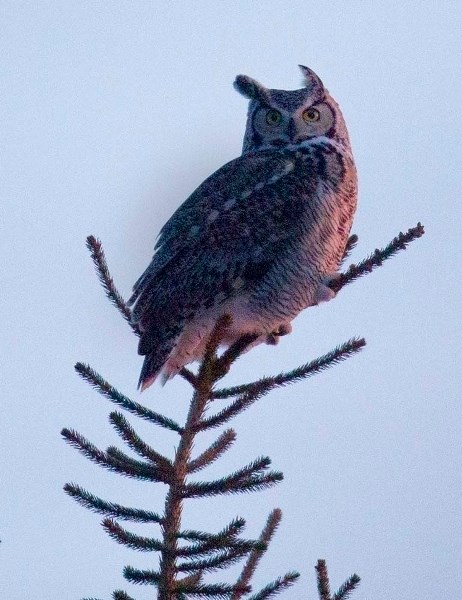It was a dark December night four years ago. I was walking home from work along Boudreau Road when I heard a strange, faint sound, just barely audible over the sound of the evening traffic. "Whoo, whoo? Whoo, whoo?" My heart soared.
It was a dark December night four years ago. I was walking home from work along Boudreau Road when I heard a strange, faint sound, just barely audible over the sound of the evening traffic.
"Whoo, whoo? Whoo, whoo?"
My heart soared. An owl! And it sounded close! Cautiously, I crept towards the sound of the owl with the patience of a panther, hugging the fence-line, watching the treetops. The hoots were so clear – surely I had to be right on top of the thing?
It was actually almost a block away, which made for a really tense 15 minutes of creeping. But I spotted it at last: a pointy-eared black blob high atop a three-storey spruce tree, silhouetted against the dull glow of the overcast sky, hooting away.
It was a great horned owl – the first one I'd ever seen in the wild.
Great horned owls are the official birds of Alberta, notes local birdwatcher Alan Hingston. They're one of the three biggest owls in the province (the others being the snowy and the great gray), and the only ones that have big, horn-like "ears" atop their heads.
Look for a football-shaped beast with a big head and big ear tufts, says Gordon Court, a provincial wildlife biologist with Alberta Fish and Wildlife who studies owls.
They're usually snoozing up near the trunks of trees during the day out of sight, which can make them harder to spot, Court notes. You're most likely to see them at dusk, which is when they're active.
"You'll see them perched on higher perches, usually silhouetted against the sky."
Their calls are another way to find them, Court says. A "hoo-hoo-hoo! Hoooo-hoo!" is a great horned, while a dog-like "woof, woof," is a great gray. Barn owls have a distinct rhythm to their calls that sounds like, "Who-cooks, for yooou?"
Watch for swarms of angry crows, magpies and chickadees as well, Hingston says. Those birds hate owls (since owls eat them), and will harass them whenever they see one.
Those aren't ears
The great horned owl's "ears" are actually just feather tufts, Hingston notes. Their real ears are on the sides of their heads near eye-level. Their disk-shaped face channels sound to these ears, giving them super-hearing.
One ear is also slightly higher than the other, which lets the owl instantly triangulate the direction from which any sound comes.
The ear tufts mostly indicate the bird's mood, Court says – they get pushed back when the owl is mad, for example.
And these are not creatures you want to tick off: most weigh about 2.5 kilograms, have wicked sharp talons, and a wingspan over a metre wide.
"It's a big owl," Court says.
Fearless predators
Great horned owls will eat everything from worms to skunks, and are known to take on porcupines, cats, and other birds much bigger than themselves, Court says.
"They call them the flying tigers," he says. "They'll eat anything that moves."
Hunting at night, great horned owls use their excellent hearing and night vision to zero in on anything foolish enough to be edible and about on their territory.
Serrated edges on their wing-feathers let them swoop down on their targets silently, while their zygodactylic (two toes forward, two back) feet let them exert about 28 pounds of spine-snapping force.
Many will zip low over waterways to snatch sleeping ducks and fish, Court says. Others will literally walk up to sleeping pigeons and slaughter them.
"They're very good at that sort of stealth manoeuvre," he says – they're like ninjas with feathers.
Court says owls swallow their prey whole where possible, allowing them to extract maximum nutrition from it. Indigestible bits like fur and bones are coughed out later as pellets. Researchers often dissect those pellets to track the locations of many small mammals in Alberta.
Watch for babies
Great horned owls breed extremely early in the season, Hingston notes – in fact, he knows of one in St. Albert's white spruce forest that's been sitting on eggs since Jan. 18.
Court says great horned owls are such good hunters that they're never short of food, meaning they can afford to breed in the winter. The two to three eggs they incubate today will hatch in around May, giving the chicks the entire summer to learn how to hunt.
Great horned owls use old crow or raptor stick-nests, Court says. If you see a lump atop one of those nests this month, it's likely a great horned.
Keep your eyes and ears open around town at dusk and you're sure to spot a great horned owl eventually. When you do, appreciate them from a distance.
"You don't want to try to go up to the nest with these birds," Hingston notes. "They are ferocious."
Great horned owl
Name:
Bubo virginianus.
Appearance:
Football-shaped owl with prominent horn-like "ear" tufts atop head. Generally brown and barred, but can also be near white or very black. Looks like it has white, angry eyebrows.
Commonly seen:
Silhouetted against the evening sky atop a tall post or tree.
Wild St. Albert
Like wildlife? So do we! Every second Wednesday the Gazette profiles a reasonably common wild creature in the St. Albert region. Birds, beasts, bugs, fish … so long as it's alive and kicking, we'll feature it. <br /><br />Got a creature you'd like to see profiled? Send your suggestions to [email protected].




